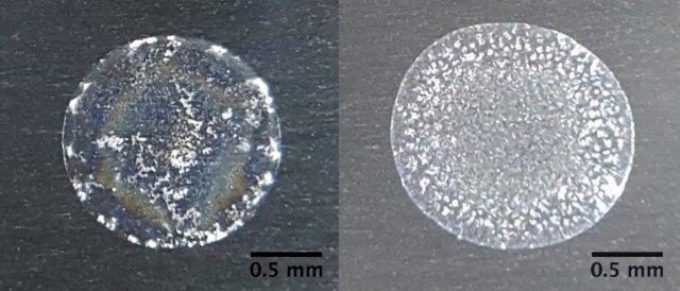Aug 23 2017
“What is in your water?” has become a progressively fraught question for many people in the U.S. and other regions of the world. An answer for that is neither easy nor cheap. Recently, Researchers are reporting that they are applying the familiar “coffee-ring effect” to test multiple components in one drop of water easily, quickly and inexpensively. And in the future, the public could use the technique to analyze the tap water they are using.
 Tap water droplets from two buildings on the Michigan State University campus leave behind different coffee-ring patterns; “hard” water is shown on the left, and water treated with a softener is shown on the right. (Credit: Xiaoyan Li)
Tap water droplets from two buildings on the Michigan State University campus leave behind different coffee-ring patterns; “hard” water is shown on the left, and water treated with a softener is shown on the right. (Credit: Xiaoyan Li)
The Researchers are showcasing their work at the 254th National Meeting & Exposition of the American Chemical Society (ACS). ACS, the largest scientific society in the world, is holding the meeting this week. It features almost 9,400 presentations on a wide variety of science topics.
In short, the coffee-ring effect is the known phenomenon where the particles in a droplet of water are inclined to concentrate around the edges of the droplet as the water evaporates.
But the patterns left by the coffee-ring effect for real-world tap water samples are more intricate and unique for each water source. There is a stunning amount of information there to analyze. The residue patterns for tap water are like fingerprints that can be used to identify what’s in a sample.
Rebecca Lahr, Ph.D
Lahr highlights that public health concerns only came to the forefront in recent times in cities like Flint, Michigan; Washington, D.C.; Toledo, Ohio and Charleston, West Virginia, after people drank contaminated tap water. These experiences show the need for better water-quality monitoring methods, she says.
Lahr has been exploring the coffee-ring effect since working on her Ph.D. thesis, initially using it to concentrate toxins in water for ensuing spectroscopic analysis. Now, she is using it in her lab at Michigan State University to help the public understand more about the liquid coming from their taps.
It turns out that the exclusive pattern left by a sample of water offers information on the properties and content of the water — dissolved solids, alkalinity, hardness and metal ions, for instance. Determining each of these items in a sample conventionally required a different analytical technique. The costs of those separate tests mount up.
If you are worried about your drinking water, it can be overwhelming to look at a water-testing fee schedule to decide which water tests to run. You have to know what you are looking for beforehand.
Rebecca Lahr, Ph.D
To perform the coffee-ring analysis, Lahr, Graduate Student Xiaoyan Li, and Undergraduates Selett Allen and Alyssa Sanderson dried droplets of a range of tap water samples on inexpensive aluminum substrates. Then, they photographed the subsequent coffee-ring effect with a cell phone through a low-cost jeweler’s loupe. After a number of experiments, they acquired reproducible residue patterns for tap waters from communities spread throughout southern Michigan.
They also formed synthetic tap water solutions to imitate community tap waters with diverse quantities of alkalinity, hardness, chloride, sulfate, sodium, iron, total dissolved solids and copper.
The goal, Lahr says, “is to create a library of patterns produced by the coffee ring effects for known water samples that can be used to identify the patterns from unknown samples.” She is also involved in programs to automate comparison of unidentified water samples to the library.
So, could the coffee-ring effect have been applied to identify the issue of lead contamination of the Flint water supply? “It’s too early to say,” Lahr responds. “The idea here is to develop a faster and cheaper way to screen samples to raise red flags when there should be further analyses performed. This method won’t have the sensitivity of standard analytical techniques, but it’s much cheaper.”
She adds that the coffee-ring effect can also be applied in classroom situations to increase the interest of students about environmental science.
I’m amazed by how powerful it is as an educational tool. Students bring in their own samples and quickly see the differences in the patterns left behind.
Rebecca Lahr, Ph.D
Coffee-ring effect used for low-cost analysis of tap water - Headline Science